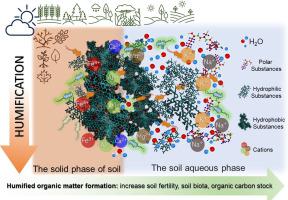Science of the Total Environment ( IF 8.2 ) Pub Date : 2022-04-12 , DOI: 10.1016/j.scitotenv.2022.155133 Tamiris Conceição de Aguiar 1 , Danielle França de Oliveira Torchia 1 , Tadeu Augusto van Tol de Castro 1 , Orlando Carlos Huertas Tavares 1 , Samuel de Abreu Lopes 1 , Lucas de Souza da Silva 1 , Rosane Nora Castro 2 , Ricardo Luiz Louro Berbara 1 , Marcos Gervasio Pereira 1 , Andrés Calderín García 1

|
腐殖质 (HS) 的结构和腐殖化过程是了解地球上碳动态的关键课题。本研究旨在通过使用固态13的光谱表征评估从不同土壤(即 Histosols、Ferralsols、Cambisols、Mollisols、Planosols 和 vermicompost 分离的 80 个腐植酸 (HA) 样品的结构模式)C核磁共振交叉极化/魔角旋转结合化学计量学技术。所有 80 个 HA 都具有相似的结构模式,无论其来源如何,但它们具有不同的相对数量的有机 C 物种。各种有机碳组分的不同结构量在每种 HA 中产生了不同的性质。这解释了为什么 HS 功能有相似之处,但为什么这些功能的强度在来自不同土壤类型和环境的样品中有所不同,证实了 HS 是一组化合物,其结构特征不同于产生它们的分子. 腐殖化过程似乎没有单一的定义。因此,对于每个来源的土壤,特定的腐殖化过程取决于当地环境的特征。腐殖化可以理解为类似于化学反应的过程,其中决定产物形成的关键因素是反应物(沉积在土壤中的有机底物)的结构特征。反应进行的程度取决于反应条件(土壤的化学、物理和生物特性)。本研究中获得的 HS 的结构模式证明了 HS 的存在结构为自组装、亲水和疏水域,在某些条件下,这些域可以发生转变,从而改变环境中有机碳的平衡。腐殖化可以理解为类似于化学反应的过程,其中决定产物形成的关键因素是反应物(沉积在土壤中的有机底物)的结构特征。反应进行的程度取决于反应条件(土壤的化学、物理和生物特性)。本研究中获得的 HS 的结构模式证明了 HS 的存在结构为自组装、亲水和疏水域,在某些条件下,这些域可以发生转变,从而改变环境中有机碳的平衡。腐殖化可以理解为类似于化学反应的过程,其中决定产物形成的关键因素是反应物(沉积在土壤中的有机底物)的结构特征。反应进行的程度取决于反应条件(土壤的化学、物理和生物特性)。本研究中获得的 HS 的结构模式证明了 HS 的存在结构为自组装、亲水和疏水域,在某些条件下,这些域可以发生转变,从而改变环境中有机碳的平衡。反应进行的程度取决于反应条件(土壤的化学、物理和生物特性)。本研究中获得的 HS 的结构模式证明了 HS 的存在结构为自组装、亲水和疏水域,在某些条件下,这些域可以发生转变,从而改变环境中有机碳的平衡。反应进行的程度取决于反应条件(土壤的化学、物理和生物特性)。本研究中获得的 HS 的结构模式证明了 HS 的存在结构为自组装、亲水和疏水域,在某些条件下,这些域可以发生转变,从而改变环境中有机碳的平衡。

"点击查看英文标题和摘要"


















































 京公网安备 11010802027423号
京公网安备 11010802027423号